#Magellanic Cloud
Text
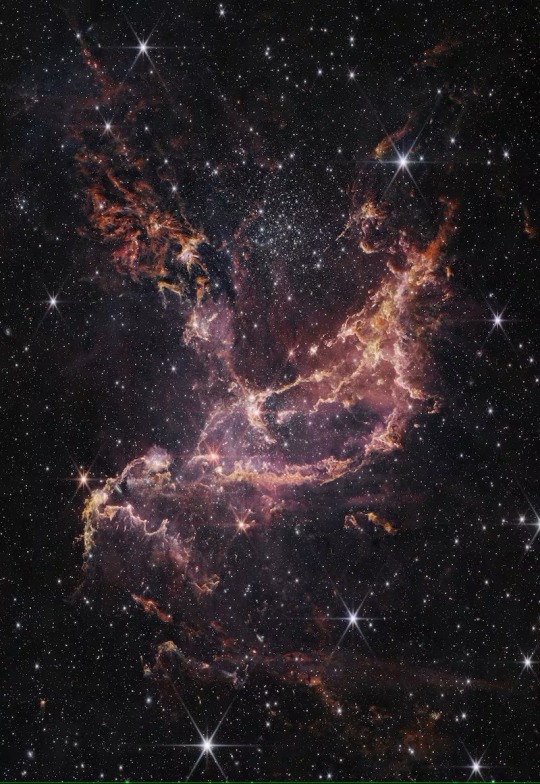
A cluster of stars in the Small Magellanic Cloud
Image taken by the James Webb Space Telescope. PA
#art#cosmos#cosmic#universe#blast#space#photography#stars#light#cluster#cloud#magellanic cloud#james webb space telescope#PA
284 notes
·
View notes
Text
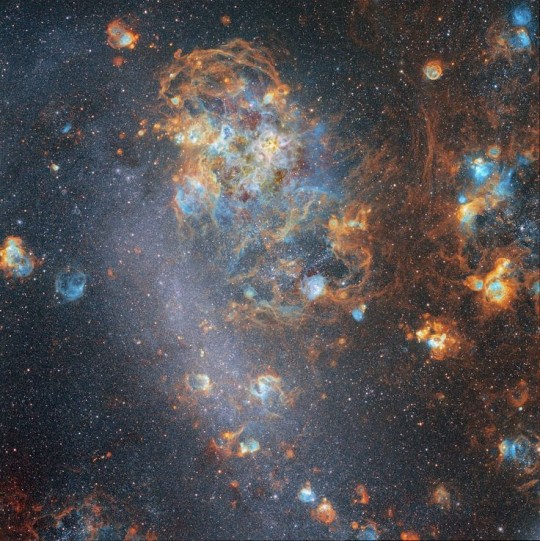
Large Magellanic Cloud, John Gleason
#magellanic cloud#large magellanic cloud#space#astrophotography#stars#nebula#galaxies#universe#space stuff#beautiful#beauty#escape#pretty#spiritual#photography#cosmic#cosmos#celestial#art#dark space#the unknown#astral#astro#orange#blue#cool shit#nature
144 notes
·
View notes
Text

#incredible hulk#fing fang foom#bruce banner#makluan#kakaranthara#immortal hulk#magellanic cloud#hulk#marvel#marvel comics
8 notes
·
View notes
Text
2024 March 16

ELT and the Milky Way
Image Credit & License: European Southern Observatory - Courtesy: Jens Scheidtmann
Explanation: The southern winter Milky Way sprawls across this night skyscape. Looking due south, the webcam view was recorded near local midnight on March 11 in dry, dark skies over the central Chilean Atacama desert. Seen below the graceful arc of diffuse starlight are satellite galaxies of the mighty Milky Way, also known as the Large and Small Magellanic clouds. In the foreground is the site of the European Southern Observatory's 40-metre-class Extremely Large Telescope (ELT). Under construction at the 3000 metre summit of Cerro Armazones, the ELT is on track to become planet Earth's biggest Eye on the Sky.
#astronaut#astronomers#not astrology#star#stars#art#astronomy#outer space#space#artist#milky way#constellation#constellations#telescope#telescopes#extremely large telescope#ELT#large magellanic cloud#magellanic cloud
5 notes
·
View notes
Text

Large Magellanic Cloud
3K notes
·
View notes
Photo
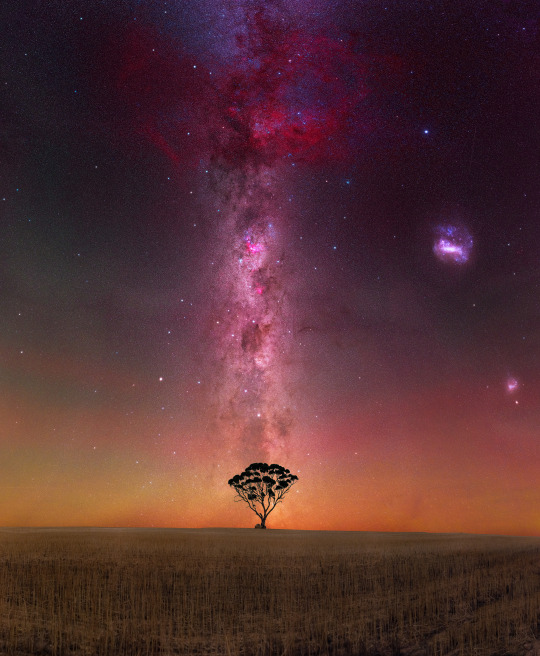
Milky Way at York, Western Australia
Nikon d810a - 50mm - ISO 6400 - f/2.5 - Foreground: 7 x 30 seconds - Sky: 35 x 30 seconds - iOptron SkyTracker - Hoya Red Intensifier filter
#Milky Way#stars#space#night#sky#Astronomy#astrophotography#landscape astrophotography#galaxy#universe#Crux#Carina#eta carinae#nebula#Magellanic Clouds#large magellanic cloud#small magellanic cloud#lone tree#gum#farm#Wheatbelt#York#Western Australia#outback
7K notes
·
View notes
Text

Some nebulae in the SMC // Chris Laurel
#astronomy#astrophotography#nebula#emission nebula#star-forming region#NGC 602#NGC 465#NGC 460#NGC 456#IC 1662#SMC#small magellanic cloud#hydrus#tucana
159 notes
·
View notes
Text
In September, astronomer Mia de los Reyes published an op-ed in the journal APS Physics, representing a coalition of astronomers calling for the renaming of two iconic, deeply studied and shining irregular galaxies near the Milky Way. One of these star-studded realms is named the Large Magellanic Cloud and the other, for reasons you'd probably expect, is named the Small Magellanic Cloud. But most importantly, what these two satellite galaxies have in common is they're named after Ferdinand Magellan.
Among other things, Magellan has gone down in history as the Portuguese explorer who murdered, enslaved and burned the homes of indigenous people while setting out to be the first person to circumnavigate the globe. As de los Reyes' article states, a first-hand account of Magellan's journey describes how he enslaved the native Teluche people, for instance, who lived in what is now Argentina, and placed iron manacles on the "youngest and best proportioned men." He's also recorded to have set entire villages ablaze in the region we now call Guam.
Continue Reading.
188 notes
·
View notes
Text
JWST's first image of 2024 is here!
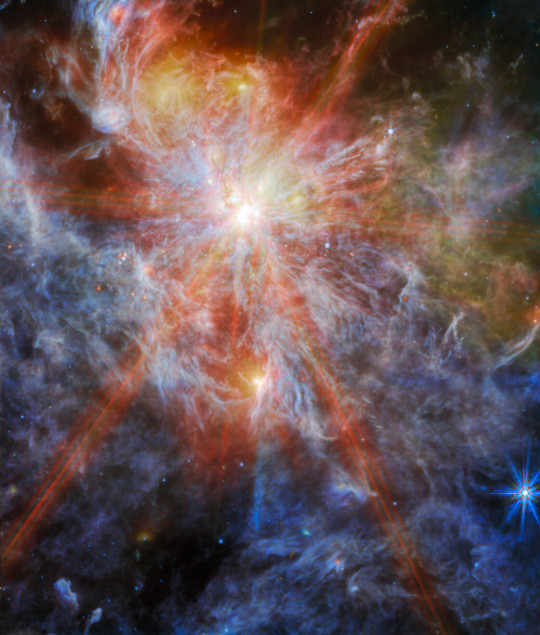
This image from the NASA/ESA/CSA James Webb Space Telescope features an H II region in the Large Magellanic Cloud (LMC), a satellite galaxy of our Milky Way. This nebula, known as N79, is a region of interstellar atomic hydrogen that is ionised, captured here by Webb’s Mid-InfraRed Instrument (MIRI).
#space#james webb space telescope#jwst#science#astronomy#nebula#large magellanic cloud#astrophysics#my post#nasa#esa
53 notes
·
View notes
Text

7,000 Stars and the Milky Way - February 13th, 1996.
"This panorama view of the sky is really a drawing. It was made in the 1940s under the supervision of astronomer Knut Lundmark at the Lund Observatory in Sweden. To create the picture, draftsmen used a mathematical distortion to map the entire sky onto an oval shaped image, with the plane of our Milky Way galaxy along the center and the north galactic pole at the top. 7,000 individual stars are shown as white dots, size indicating brightness. The "Milky Way" clouds, actually the combined light of dim, unresolved stars in the densely populated galactic plane, are accurately painted on, interrupted by dramatic dark dust lanes. The overall effect is photographic in quality and represents the visible sky. Orion is at the right edge of the picture, just below the galactic plane, and the Large and Small Magellanic Clouds are visible as fuzzy patches in the lower right quadrant."
#nasa#space#cosmos#universe#astronomy#astrophysics#astrophotography#milky way#stars#orion#large magellanic cloud#small magellanic cloud
41 notes
·
View notes
Text
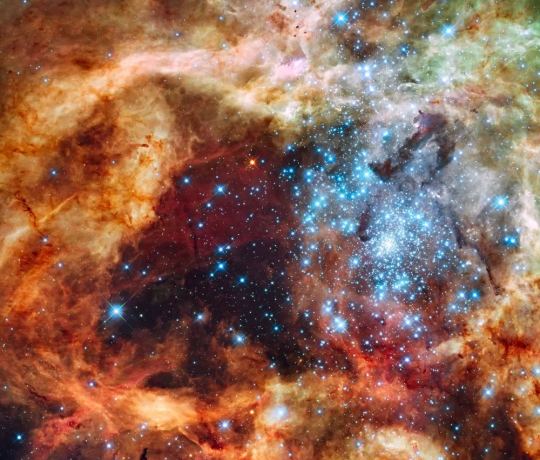
Tarantula Nebula !
This is a Hubble Space Telescope image of a star-forming region containing massive, young, blue stars in 30 Doradus, the Tarantula Nebula. Located within the Large Magellanic Cloud, this is one of the regions observed by a newly-completed survey named ULLYSES.
Some stars are so massive and so energetic that they’re a million times brighter than the Sun. This type of star dominated the early Universe, playing a key role in its development and evolution. The first of its kind are all gone now, but the modern Universe still forms stars of this type.
Image Credit: NASA, ESA, STScI, Francesco Paresce (INAF-IASF Bologna), Robert O'Connell (UVA), SOC-WFC3, ESO
#art#cosmos#cosmic#universe#blast#space#photography#stars#nebula#tarantula nebula#hubble space telescope#30 doradus#magellanic cloud#ullyses#nasa#esa
117 notes
·
View notes
Text

NGC 1466; Globular Star Cluster in Hydrus- ESA, Hubble & NASA
#stars#star cluster#universe#galaxies#hydrus#constellations#magellanic cloud#milky way#cosmic#cosmos#celestial#space#deep space#galactic#dark space#mysterious#mystical#we are all connected#astrophotography#beautiful#beauty#escape#pretty#art#spiritual#photography#gold#nasa#hubble#goegeous
99 notes
·
View notes
Text
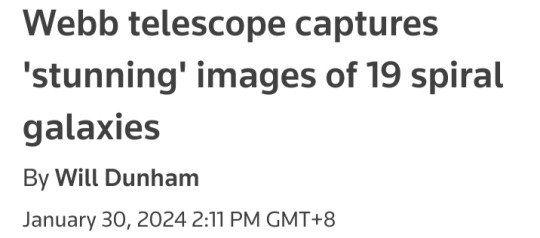
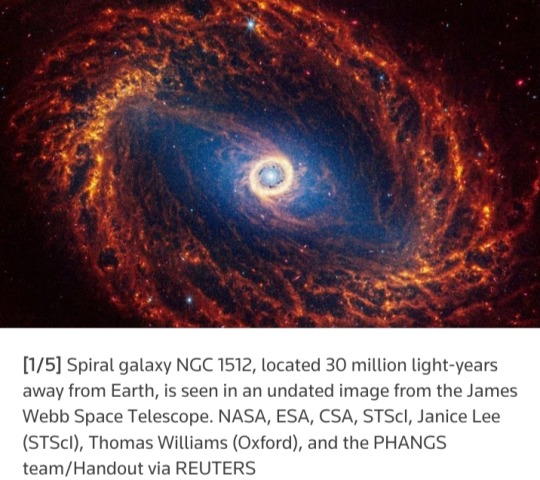
WASHINGTON, Jan 29 (Reuters) — A batch of newly released images captured by the James Webb Space Telescope show in remarkable detail 19 spiral galaxies residing relatively near our Milky Way, offering new clues on star formation as well as galactic structure and evolution.
The images were made public on Monday by a team of scientists involved in a project called Physics at High Angular resolution in Nearby GalaxieS (PHANGS) that operates across several major astronomical observatories.
The closest of the 19 galaxies is called NGC5068, about 15 million light years from Earth, and the most distant of them is NGC1365, about 60 million light years from Earth.
A light year is the distance light travels in a year, 5.9 trillion miles (9.5 trillion km).
The James Webb Space Telescope (JWST) was launched in 2021 and began collecting data in 2022, reshaping the understanding of the early universe while taking wondrous pictures of the cosmos.
The orbiting observatory looks at the universe mainly in the infrared.
The Hubble Space Telescope, launched in 1990 and still operational, has examined it primarily at optical and ultraviolet wavelengths.
Spiral galaxies, resembling enormous pinwheels, are a common galaxy type. Our Milky Way is one.
The new observations came from Webb's Near-Infrared Camera (NIRCam) and Mid-Infrared Instrument (MIRI).
They show roughly 100,000 star clusters and millions or perhaps billions of individual stars.
"These data are important as they give us a new view on the earliest phase of star formation," said University of Oxford astronomer Thomas Williams, who led the team's data processing on the images.
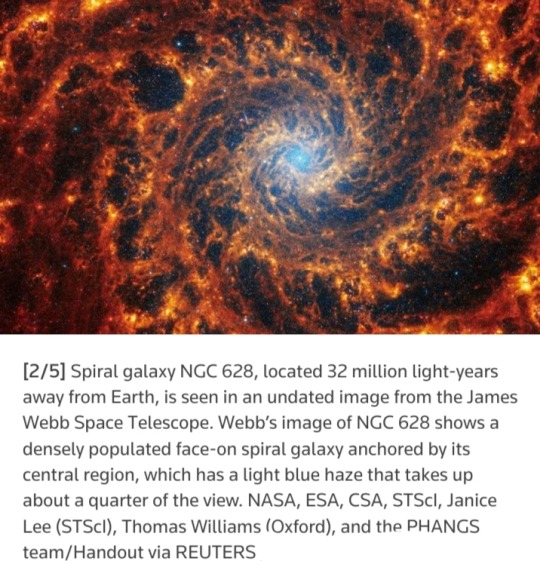
"Stars are born deep within dusty clouds that completely block out the light at visible wavelengths - what the Hubble Space Telescope is sensitive to - but these clouds light up at the JWST wavelengths.
We don't know a lot about this phase, not even really how long it lasts, and so these data will be vital for understanding how stars in galaxies start their lives," Williams added.
About half of spiral galaxies have a straight structure, called a bar, coming out from the galactic center to which the spiral arms are attached.
"The commonly held thought is that galaxies form from the inside-out, and so get bigger and bigger over their lifetimes.
The spiral arms act to sweep up the gas that will form into stars, and the bars act to funnel that same gas in towards the central black hole of the galaxy," Williams said.

The images let scientists for the first time resolve the structure of the clouds of dust and gas from which stars and planets form at a high level of detail in galaxies beyond the Large Magellanic Cloud and Small Magellanic Cloud, two galaxies considered galactic satellites of the sprawling Milky Way.
"The images are not only aesthetically stunning, they also tell a story about the cycle of star formation and feedback, which is the energy and momentum released by young stars into the space between stars," said astronomer Janice Lee of the Space Telescope Science Institute in Baltimore, principal investigator for the new data.
"It actually looks like there was explosive activity and clearing of the dust and gas on both cluster and kiloparsec (roughly 3,000 light years) scales.
The dynamic process of the overall star formation cycle becomes obvious and qualitatively accessible, even for the public, which makes the images compelling on many different levels," Lee added.
Webb's observations build on Hubble's.

"Using Hubble, we would see the starlight from galaxies, but some of the light was blocked by the dust of galaxies," University of Alberta astronomer Erik Rosolowsky said.
"This limitation made it hard to understand parts of how a galaxy operates as a system. With Webb's view in the infrared, we can see through this dust to see stars behind and within the enshrouding dust."
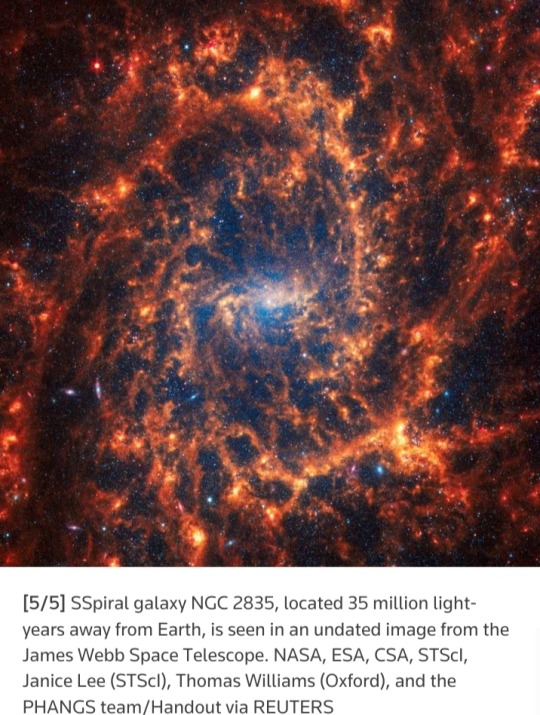
#James Webb Space Telescope#spiral galaxies#Milky Way#Physics at High Angular resolution in Nearby GalaxieS (PHANGS)#NGC5068#NGC1365#light year#Hubble Space Telescope#Near-Infrared Camera (NIRCam)#Mid-Infrared Instrument (MIRI)#astronomy#space#universe#cosmos#Large Magellanic Cloud#Small Magellanic Cloud#Space Telescope Science Institute
37 notes
·
View notes
Text

Adele and Fisherman Islands in Abel Tasman National park - 2022
#new zealand#nz#photographers on tumblr#original photographers#space#stars#astrophotography#night#sky#universe#Adele island#fisherman island#astrolabe roadsted#Abel Tasman National park#abel Tasman#nelson#south island#te wai pounamu#te waka a maui#Magellanic clouds#southern hemisphere#galaxies#sea#ocean#beautiful#life#kiwi#nature#trees#French
488 notes
·
View notes
Text

Large Magellanic Cloud
2K notes
·
View notes
Text

Summer Milky Way at Lake Ninan, Western Australia
Nikon d810a - 50mm - ISO 6400 - f/2.8
Foreground: 11 x 6 seconds
Sky: 30 x 30 seconds
iOptron SkyTracker
Nantong Foric H-Alpha 20nm narrowband filter
#Milky Way#night#sky#stars#space#astrophotography#landscape astrophotography#astronomy#galaxy#western australia#Lake Ninan#salt lake#Magellanic Clouds#Carina#nebula#Crux#Gum Nebula#pressure ridges#airglow#nikon#d810a#iOptron#SkyTracker
738 notes
·
View notes